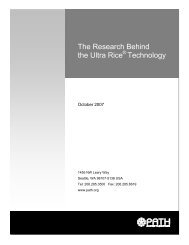Guidelines on stock records for immunization programme - Path
Guidelines on stock records for immunization programme - Path
Guidelines on stock records for immunization programme - Path
Create successful ePaper yourself
Turn your PDF publications into a flip-book with our unique Google optimized e-Paper software.
Step 1<br />
When vaccine c<strong>on</strong>signments arrive at a storage point their details are checked<br />
and recorded.<br />
All details of each c<strong>on</strong>signment must be checked and recorded in the <strong>stock</strong> register.<br />
(In the case of internati<strong>on</strong>al shipments, see also Annex 1 <strong>on</strong> checking vaccine<br />
shipments <strong>on</strong> arrival.)<br />
The details to be recorded include:<br />
• type of vaccine<br />
• presentati<strong>on</strong> (vial size)<br />
• quantity received (doses)<br />
• vaccine manufacturer<br />
• manufacturing batch or lot number or numbers (there may be more than <strong>on</strong>e<br />
batch or lot in a c<strong>on</strong>signment)<br />
• expiry date <strong>for</strong> each batch<br />
• status of temperature m<strong>on</strong>itoring indicators - VVM, cold chain m<strong>on</strong>itor (CCM),<br />
freeze indicators and electr<strong>on</strong>ic data loggers <strong>on</strong> arrival of the c<strong>on</strong>signment.<br />
In c<strong>on</strong>signments of freeze-dried vaccine, each shipment should always arrive with<br />
the correct quantity of diluent <strong>for</strong> rec<strong>on</strong>stituting the vaccine when it reaches the<br />
user. For such shipments, the following details must also be checked and recorded<br />
<strong>for</strong> the accompanying diluent:<br />
• type of diluent (i.e. type of vaccine with which it is to be used)<br />
• quantity received (doses)<br />
• diluent manufacturer<br />
• manufacturing batch or lot number or numbers (there may be more than <strong>on</strong>e<br />
batch or lot in a c<strong>on</strong>signment)<br />
• expiry date <strong>for</strong> each batch<br />
Step 2<br />
During the time that vaccine <strong>stock</strong>s are in storage their details and c<strong>on</strong>diti<strong>on</strong>s<br />
are checked.<br />
All vaccines and diluents have an expiry date, after which they must not be used.<br />
All <strong>stock</strong>s must be distributed well be<strong>for</strong>e their expiry date in order to allow sufficient<br />
time <strong>for</strong> them to pass through the distributi<strong>on</strong> system and reach the user.<br />
EEFO handling is safer than first-in-first-out (FIFO) handling. In general,<br />
when two batches of vaccine are delivered at different times, the sec<strong>on</strong>d to arrive<br />
has a later expiry date than the other. However, this is not always the case, particularly<br />
when vaccines are obtained from different sources. The expiry date should always<br />
be checked and the vaccine with the shortest shelf-life should be distributed first,<br />
even if it arrived last.<br />
WHO/IVB/06.12<br />
9

















